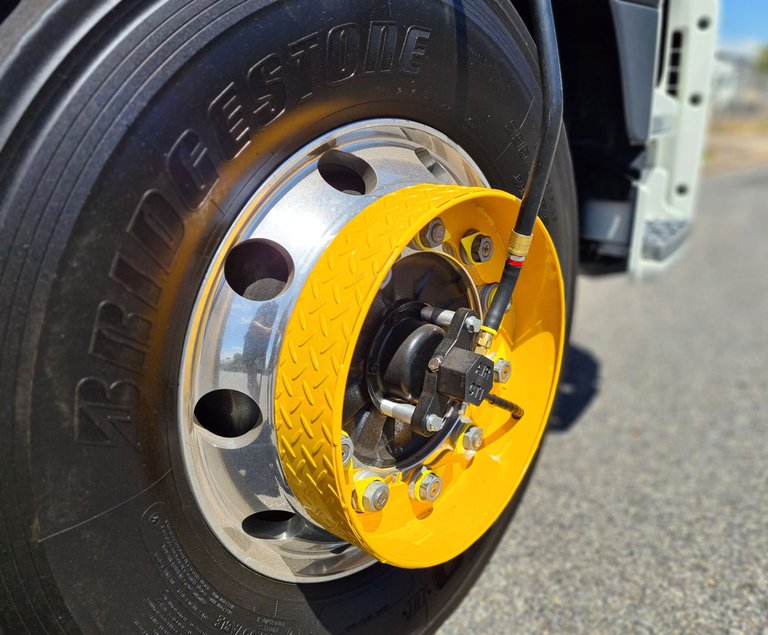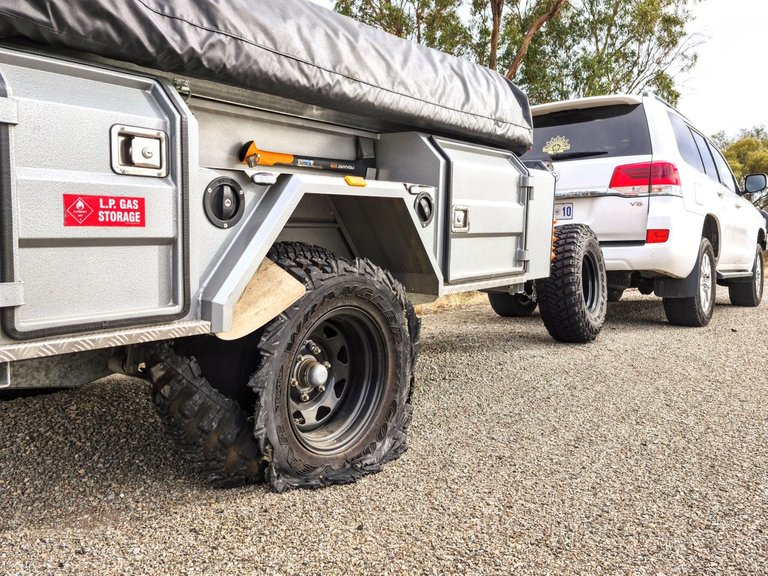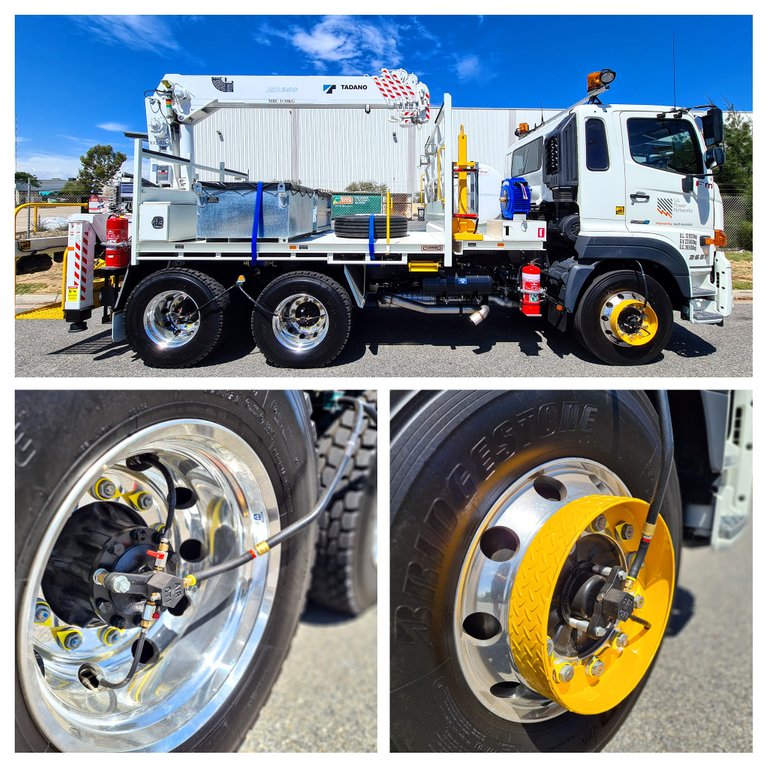Full of air...and not

As a person who off-roads a lot I'm familiar with airing down my vehicle's tyres. It increases the tyre's footprint on the terrain spreading the load over a greater area and that allows for greater traction. Furthermore, it lessens the chance of staking, a stick or foreign object entering the tyre, and causing a puncture - Imagine a balloon inflated to a very tight state compared to it being half-inflated. The latter is more pliable when poked; it's the same principle with tyres. An increased footprint and greater traction also mean the environment doesn't get torn up as much by the tyres. So changing tyre pressure is important.
Airing down, or deflating, tyres should only be done on loose surfaces and when running-speed is low. On a bitumen or sealed road the increased flex in the sidewall will cause heat build-up and eventually tear the tyre apart. This happened to me last year when my camper trailer tyre deflated whilst running at 120kph.
This means that once the vehicle is back on a hard road the tyres will need re-inflating. I have an air compressor to do this and have written about it before; you can see it here.

This happened at 120kph. The tyre had a slow leak and deflated to about half-pressure. The additional flex in the sidewall heated it up. Eventually it became so hot the hub spinning simply tore the sidewall away from the tread resulting in a catastrophic failure. This could have ended very badly for me at that speed. I now have a TPMS which you can read about in a link further down.
Other options
Here's a vehicle my company recently fitted a tyre pressure management system to. This is a truck that operates on and off-road servicing high voltage power lines; it's a serious job and a serious truck. This one is a small crane-truck and some of the others are much larger, the ones that lift people up in buckets to work high up on the high voltage towers.
Often these vehicles are in situations in which the roads are in very poor condition and with the amount of off-road use these vehicles get the operators require tyre pressure management systems to be fitted and that's where we come in. We install this system that can deflate and re-inflate tyres to set pressures at the touch of a button, without exiting the vehicle.

There's many benefits to controlling tyre pressure including maximising tyre life, a huge issue on vehicles that have so many tyres and are constantly on the road. Adjusting the pressure means the tyre will operate more effectively and remember about the staking thing I mentioned? Getting punctures or replacing worn tyres is costly. Whether the vehicle is on gravel, dirt, rocks, mud or corrugations the in-cab-operated tyre pressure system means the right pressure can be selected easily and quickly set and without exiting the vehicle.
Benefits extend to better ride, traction, more efficient braking, better fuel economy and improved steering plus more. In short, the vehicle is far more productive, cost-efficient and comfortable for the crew.
Safety is also improved by selecting the right pressure for the moment providing better grip, shorter braking distances and straighter stops which leaves drivers feeling more confident and reducing driver-stress. This means a better and more healthy workplace for crews that are often under enough stress as it is, especially when working on high voltage power lines and often in poor environmental conditions.
Keeping personnel happy and healthy makes for greater productivity and reduced costs: Sick pay, replacement labour, overtime, medical expenses and possible workers compensation can hit the bottom line hard.
From a vehicle perspective, managing tyre pressure can mean less maintenance as well.
Corrugated roads exert a lot of force through vibration and that can cause additional maintenance and component replacement, not to mention fatigue on the occupants of course. Reducing tyre pressure helps to mitigate the vibration improving the overall ride and stress on the mechanicals and tyres. That all means additional cost savings, time saving and a better ability for the company to service their customers through increased up-time.
There are so many benefits to tyre pressure management with the above being only the main ones. It saves companies many thousands of dollars per vehicle over its life and whilst this particular system doesn't come cheap it is well worth the expense.
The principles of tyre pressure management are rather simple but in application can seem quite complicated. I've been off-roading for many years and have learned what to do and when depending on the terrain and requirements of the situation. I also have the equipment to make airing down and back up easy and accurate including an on-board tyre management system...although mine doesn't inflate and deflate from the cabin. I wrote a post about it which you can see here if you like.
One doesn't need to be an expert or spend many thousands of dollars to look after tyres and gain the benefits. It's as simple as checking and adjusting tyre pressure once a week, a quick visual inspection, keeping them correctly balanced and the vehicle wheel aligned. Sure, it costs a little money, but so does not doing it through excessive tyre wear and safety is compromised - who knows, doing this simple check once a week could save your life or someone else's.
Anyway, that's just a little piece on one of the trucks we worked on recently. We do a lot of these actually and it's always really cool to see these systems in action. I hope this wasn't too boring for you.
Design and create your ideal life, don't live it by default - Tomorrow isn't promised so be humble and kind
All of these images are my own
Wow I would love that tyre management system. some pain in the arse pumping them up manually.
It's a good system...It's not cheap though.
Once Musk gets his hands on it , he will mass produce it for nothing.
Yeah he can pump up his own, already over-inflated ego even further. Hopefully he pops completely. That'd be fun.
Very cool tire pressure system, but those hoses going into the hubs look like they would get snagged on plenty of things, especially if you're frequently going off road a lot. For me, personally, it would probably be a year working around this thing before I quit snagging my tool belt on those lines on the front wheels! :D
Yeah, I thought the same, but all of their trucks have it, hundreds of them and a lot of military vehicles also. Seems to be a tried and tested system used around the world. We don't see any back and have a constant stream of trucks rolling in for them to be fitted. I'd never have one on my own 4x4 of course. One more thing to go wrong. I'm simple and am happy to stick with simple systems.
LOL, yes I'm a fan of simplicity myself. I look at that truck and think 'That's cool... but the guys at my work would rip that off in an hour!'
In my experience, every automation that saves time in the field just costs more time in the shop! 😂
There's maintenance required for sure, but it must work out in the companies favour or they wouldn't use it I suppose. It's something that I might follow up on actually as you've now made me curious about the ongoing general maintenance.
I was curious because the rollers we have at work have a similarly placed hydraulic hose on the outside of the drums to activate the vibrators, and those suckers get caught on everything.
Also, here in America all sorts of things like this can get mandated just because some manufacturer has the right political connections. If they can make a case that it improves safety or the environment, it doesn't have to work or be cost effective.
Hopefully the political situation is at least a little better in Aussie land. 😁
Haha, don't even get me started about the political situation here. Farcical, doesn't even cover it. Different issues than you folks, sort of, same nutbaggery.
Riding dirt terrain driving regularly, one would require equipment to inflate and deflate tyres constantly according to conditions.
City driving weekly check on tyres, water and oil became a habit, cars today mostly require only tyre pressure check, normally I try to use same pump station finding some calibrate systems differently over here (not regularly serviced).
Trucks being able to do this as required must really assist those who change conditions continuously during a day.
Monster blowout on the tyre you had, another expensive item to replace!
Most don't know how to properly check pressures and do tyre checks, let alone anything else on a car. If it breaks throw it into landfill and get a new one, paid for with credit of course.
Little knowledge gleaned from the guys over the years has helped, loose spark plug in past being one thing I became quiet familiar with on one vehicle.
Wish I ran credit like that, cars are expensive here along with repairs, spares parts and everything else, yet you have to have wheels, with no public transport to swank about at all.
Yeah, must be difficult there. I guess I don't fully understand as I've not been there but I'm gaining an idea.
Don't try understand the place, if you visit be in/out enjoy!
I see it every day, overloaded SUV's with tires bulging, way past the rated weight/pressure settings. A Blowout waiting to happen...
Similar here or tyres as smooth as a baby's bottom, driving roads is quite an experience to what we used to have, potholes, abusive drivers, overloaded vehicles, speeding in a nutshell put blinkers on and go!
This is a good idea.
Does the truck have to be stopped? Im trying to figure out if it could work while moving (racing applications) and I'm drawing blanks because when pressurized the connection probably wouldn't like friction caused by spinning.
The system is operated when stationary, for safety reasons. I'm not sure what you mean about the friction thing...The wheels turn when the vehicle is moving but the connections are static. It's an ingenious system really.
At the point of connection, it would have to allow rotation or the line would become a twisted mess very quickly. It looks like it is in the center of the wheel to avoid other movement (normally the inlet is closer to the edge). When pressurized, instead of the hose and wheel smoothly rotating, there would be friction. It's sort of like how a chair is harder to move when youbare sitting on it.
However if the vehicle is stopped while there is pressure, it wouldn't matter.
That's why I asked if it has to be stopped. I was wondering if it was using some kind of other trick.
Indeed, that's how it works. For safe operation the SOP is the vehicle is stationary.
I'm thinking of all the good applications and it is exciting.
My company used to have a division that made construction vehicles, but sold it. They were experimenting with 5g remote control and little drones (air and track based) that would be used to check and stuff with the heavy stuff. A few had air guns and flame torches, but I'm not sure anything powerful enough to fill truck tires. This system would be handy for dump trucks and other equipment that regularly has to travel on and off work sites.
Indeed, the use case is certainly there and site access is exactly what the system is designed for. It operates pretty quickly also, saving time.
I was only vaguely aware that such things existed so there you go XD
Shredding tyres is one of my major non-other-car related driving anxieties x_x
Shredding is good if one is surfing or making coleslaw. When driving it is bad.
Playing the guitar is also an acceptable time to shred.
Shredding on one's axe is most righteous.
Hell on the tires sidewalls tho, at least on primes
Do they make em for heavy haul offroad down there with a sidewall that can stand up to low pressure flex.?
They indeed do. A lot of linehaul driving is done on remote areas areas and systems like this are required.